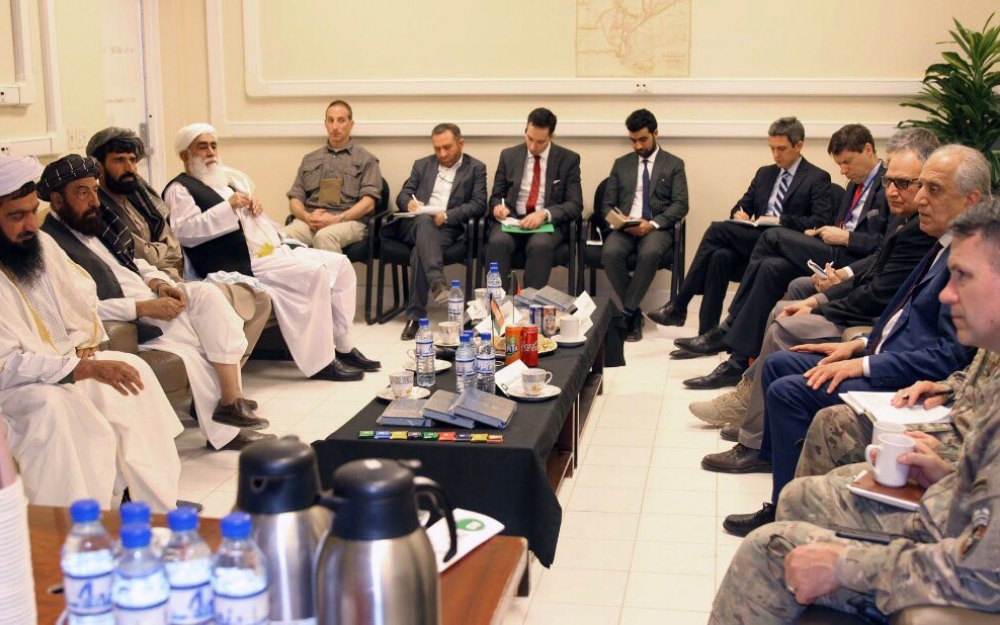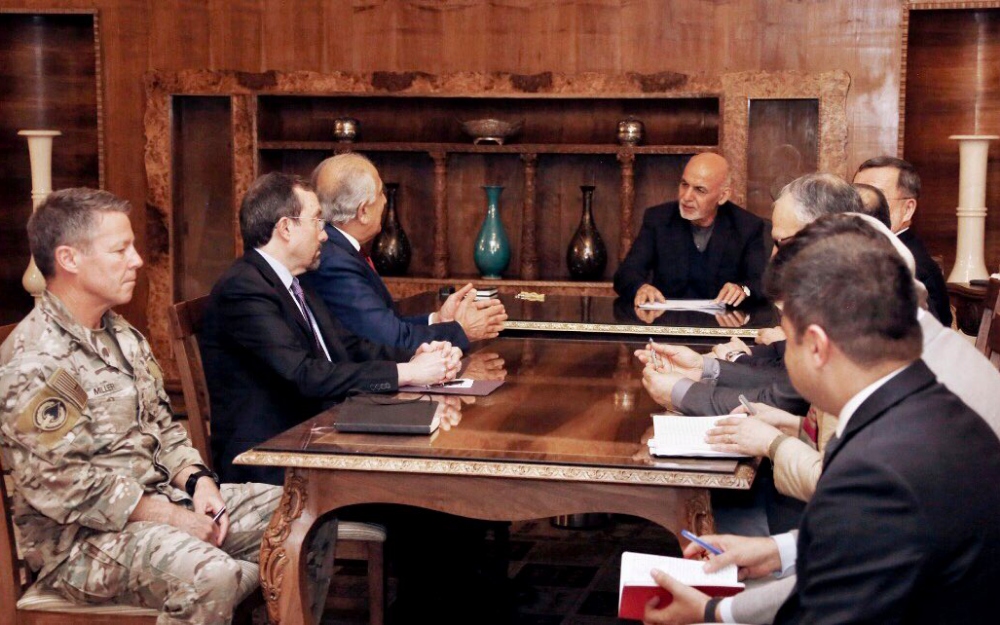Frud Bezhan
When the United States’ special representative for Afghan reconciliation arrived in Kabul this week amid ongoing peace talks with the Taliban, the country’s national-unity government was in disarray.

Zalmay Khalilzad met with the leaders of the government, President Ashraf Ghani and Chief Executive Abdullah Abdullah, separately on April 1: Ghani with his running mate in the upcoming elections; and Abdullah, the de facto prime minister, with the country’s foreign minister, an electoral ally.
Meanwhile, Ghani’s national-security adviser — who is overseeing Kabul’s ongoing war effort and recently had a much-publicized falling out with Washington — was not in Kabul at all, but in the remote province of Nuristan.
The developments, analysts say, highlighted stark divisions within the government in Kabul that have been laid bare as the United States and the Taliban carry on negotiations aimed at ending the nearly 18-year war. The Afghan government, with no seat at the table, has essentially been shut out of its own peace process, relegated to lame-duck status as Washington talks of a military withdrawal and presidential elections approach in September.
Peace Requires Broader ‘Buy-In’
The Taliban has refused to negotiate with Ghani’s administration, calling it a U.S. “puppet.” Adding to the ignominy of being left out of the U.S.-Taliban negotiations in Qatar, some of the president’s rivals held high-profile meetings with Taliban negotiators in Moscow in February. Those talks marked the most significant contact between senior Afghan political figures and the militant group since the U.S.-led invasion in 2001. The sides are expected to meet again this month.

Meanwhile, Ghani has alienated much of the country’s political elite, including influential ex-President Hamid Karzai and former warlords who attended the Moscow meeting, by failing to consult with them over the government’s national peace plan and denying them a spot on the government’s negotiating team.
“The current isolation of the Afghan government from the peace process is the result of its own failed policies and internal divisions,” says Haroun Mir, a Kabul-based political analyst.
Ghani is expected to convene a consultative Loya Jirga, a traditional assembly of tribal, ethnic, and religious leaders, in the coming weeks to reach national consensus on peace talks with the Taliban. But is unclear who will be invited and whether he will actually carry out the gathering’s suggestions.
“Peace cannot be concluded by the executive office of the president or his appointees,” says Barnett Rubin, a former U.S. State Department official and leading expert on Afghanistan. “It requires much broader participation and buy-in.”
His administration already considered by many Afghans to be weak and ineffective, Ghani’s position and leverage have been further eroded as the clock winds down on his first term in office. While he will run in the upcoming elections — postponed until September — he is not expected to win. And there is a possibility that the vote could be canceled altogether in the event of a peace settlement and the formation of an interim government that the Taliban would join.
The idea has been floated by Khalilzad and has been supported by the Taliban and Afghan opposition figures, although Ghani has rejected it.
‘No Negotiations At All’
The United States long refused to hold direct talks with the Taliban unless the Afghan government was involved. But that changed under President Donald Trump, who has expressed a desire to end the war and withdraw U.S. troops.
One of the Taliban’s conditions for negotiations was that the Afghan government not be involved, and while NATO has said it is “no way possible” to have a lasting peace without the full involvement of the Afghan government, the United States has been less declarative. U.S. Secretary of State Mike Pompeo has stressed the need for the government to be involved, while Khalilzad has suggested that a formula for bringing the government into an Afghan-owned peace process was still being developed.
“The choice the U.S. faced was between direct negotiations with the Taliban and no negotiations at all,” Rubin says. “I am sure that the U.S. government would have much preferred direct Taliban-government talks or a trilateral format, but the Taliban refused.”
with the Taliban, culminating in a draft agreement on two of the four core components of a settlement: a Taliban guarantee to prevent international terrorist groups from basing themselves in Afghanistan, and conditions for the withdrawal of U.S. forces.
A cease-fire and intra-Afghan talks over a political settlement with the Taliban, which will likely be part of a new government, would involve the Afghan government, Khalilzad said.
Significantly, Washington appears to view the Kabul government as one of three Afghan stakeholders in any political settlement, not the central player.
Pompeo suggested as much when he said in February that the “Afghan government, other Afghan leaders, and the Taliban” needed “to sit together and negotiate a political settlement.”
Deal That ‘Doesn’t End In Peace’
The Ghani administration’s simmering anger at being left out the peace negotiations boiled over on March 14, when his national-security adviser, Hambullah Mohib, launched a blistering attack on Khalilzad.
In remarks that stunned U.S. officials, Mohib said the U.S.-Taliban talks were “decreasing the legitimacy of the Afghan government” and suggested that Khalilzad had sidelined Afghan leadersbecause of his ambitions to be a “viceroy” in an interim government if the negotiations succeed.
Reports in the U.S. media said U.S. officials had since ended contacts with Mohib, jeopardizing a key relationship at a time when Kabul is running out of time and friends.
Copyright (c) 2019. RFE/RL, Inc. Reprinted with the permission of Radio Free Europe/Radio Liberty, 1201 Connecticut Ave NW, Ste 400, Washington DC 20036.










